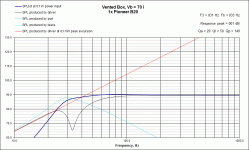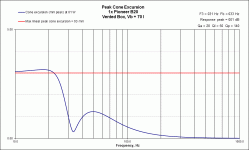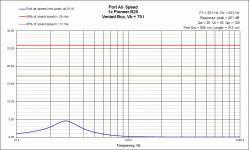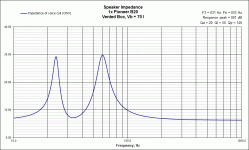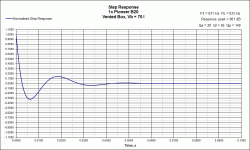Hi,
I would like to design and build my self new simple budget speakers, for tv and listening.
I took a look around and as a first project it seems that the B20FU20-51FW would be the right choice, decent quality and listenable performance. I would as well ad a tweeter or something to help with the higher frequency.
S far I downloaded the WinISD to design a simple box.
Out of that I played around and got this:
A 7Ol box with a 40hz at -3db and 32hz at -8db
here comes my question, I know the box volume and can calculate the dimentions, but ISD gives me a tuning freq. how do I achieve that? As that is something I can influence in design, but dont know what it is.
To make it simple, I attach a screen shot of the situation:

I would as well need to get the line more "stable between 50-100Hz"
but for now I just would like to know how do I in real influence the tuning freq. and as well the ISD gives me the dimentions, but says nothing about the position of the driver... how do I find out the right position of the driver?
Any one who can advice?
Thanks,
Daniel
I would like to design and build my self new simple budget speakers, for tv and listening.
I took a look around and as a first project it seems that the B20FU20-51FW would be the right choice, decent quality and listenable performance. I would as well ad a tweeter or something to help with the higher frequency.
S far I downloaded the WinISD to design a simple box.
Out of that I played around and got this:
A 7Ol box with a 40hz at -3db and 32hz at -8db
here comes my question, I know the box volume and can calculate the dimentions, but ISD gives me a tuning freq. how do I achieve that? As that is something I can influence in design, but dont know what it is.
To make it simple, I attach a screen shot of the situation:

I would as well need to get the line more "stable between 50-100Hz"
but for now I just would like to know how do I in real influence the tuning freq. and as well the ISD gives me the dimentions, but says nothing about the position of the driver... how do I find out the right position of the driver?
Any one who can advice?
Thanks,
Daniel
Download WinISD Pro.
Try looking at the "Vents" tab - play around with port area and length, see how tuning changes.
Lots of reading here - scroll down to "Baffle dimensions and diffraction"
http://www.diyaudio.com/forums/diyaudio-com-articles/158899-arpeggio-loudspeaker.html
Chris
Try looking at the "Vents" tab - play around with port area and length, see how tuning changes.
Lots of reading here - scroll down to "Baffle dimensions and diffraction"
http://www.diyaudio.com/forums/diyaudio-com-articles/158899-arpeggio-loudspeaker.html
Chris
A few general points.
Firstly, the Pioneer B20 was discontinued several years ago, so you'll either need 2nd hand, or to find somewhere with some gathering dust on a shelf.
Since I get rather different results for the same 70 litre Vb and 36.57Hz Fb indicated in the WinISD shot you attached, I suspect you are using different driver data. I used the ones published on the PartsXpress site, and assuming these, you should get somewhat better results than what you have indicated, although I would be inclined to tune a touch lower, to 33Hz. A fractional response peak as you can see, since the box is a little smaller than the driver prefers, but nothing to cause major problems. As Chris mentions, WinISD Pro, though not without bugs, is preferable to the stock WinISD.
In practice, you don't want a flat response in the LF; that's a quasi-anechoic simulation which does not take into account baffle losses (not necessarily a huge issue in all situations -depends on where the boxes are placed relative to room boundaries), or room-gain. The latter will tend to cause excessive peaking on the bottom end if you model for a flat response, so in practice, it's usually better to employ a more damped output, for e.g. the attached, from my prefered Unibox.
There have been many designs using the B20 discussed on this forum; if you run a search you should find quite a few. These may help give you some additional ideas.
Firstly, the Pioneer B20 was discontinued several years ago, so you'll either need 2nd hand, or to find somewhere with some gathering dust on a shelf.
Since I get rather different results for the same 70 litre Vb and 36.57Hz Fb indicated in the WinISD shot you attached, I suspect you are using different driver data. I used the ones published on the PartsXpress site, and assuming these, you should get somewhat better results than what you have indicated, although I would be inclined to tune a touch lower, to 33Hz. A fractional response peak as you can see, since the box is a little smaller than the driver prefers, but nothing to cause major problems. As Chris mentions, WinISD Pro, though not without bugs, is preferable to the stock WinISD.
In practice, you don't want a flat response in the LF; that's a quasi-anechoic simulation which does not take into account baffle losses (not necessarily a huge issue in all situations -depends on where the boxes are placed relative to room boundaries), or room-gain. The latter will tend to cause excessive peaking on the bottom end if you model for a flat response, so in practice, it's usually better to employ a more damped output, for e.g. the attached, from my prefered Unibox.
There have been many designs using the B20 discussed on this forum; if you run a search you should find quite a few. These may help give you some additional ideas.
Attachments
hmmmm i downloaded the WinISD Pro and I try to enter the GRS 8FR-8 Full-Range 8" Speaker Pioneer Type B20FU20-51FW 292-430
since the preivous is really out of stock and it gives me a error on consitancy with the driver parameters...
If nothing works a fall back plan is to use the Alpair 10.2, its more expensive and I thought to set it up as my second project, bud should I have problems with the Pioneer, I might skip them, but anyway I will still have the same questions
since the preivous is really out of stock and it gives me a error on consitancy with the driver parameters...
If nothing works a fall back plan is to use the Alpair 10.2, its more expensive and I thought to set it up as my second project, bud should I have problems with the Pioneer, I might skip them, but anyway I will still have the same questions
That will be because it calculates some parameters derived from others which you have entered. This is rather useful because nine times out of ten, the specifications on data sheets are inconsistent with each other since they are typically average values for a batch. You can do the same thing manually of course, but it saves time to let the software do it, and this is probably what I use WinISD for most (quickly checking driver specs.)
Here's one way: enter Qe, Qm, B*L, Sd, Re, Xmax & max. power handling if available, and let it calculate the rest. Alternatively, enter Qe, Qm, Sd, Mms, Re, Xmax & max. power handling. Same deal.
Incidentally, those specs. you picture above are far removed removed from the ones on PE, which are TTBOMK reasonably representative of the last B20s. I've certainly never seen a B20 with a 0.2 Qt or an Fs of 29Hz, so IMO they are way out.
GRS against Alpair 10.2? The latter is smaller, but it's a much more expensive & ultimately much higher quality product, with a reasonable number of cabinet designs available.
Here's one way: enter Qe, Qm, B*L, Sd, Re, Xmax & max. power handling if available, and let it calculate the rest. Alternatively, enter Qe, Qm, Sd, Mms, Re, Xmax & max. power handling. Same deal.
Incidentally, those specs. you picture above are far removed removed from the ones on PE, which are TTBOMK reasonably representative of the last B20s. I've certainly never seen a B20 with a 0.2 Qt or an Fs of 29Hz, so IMO they are way out.
GRS against Alpair 10.2? The latter is smaller, but it's a much more expensive & ultimately much higher quality product, with a reasonable number of cabinet designs available.
So I managed to put the Pioneer into the WinISD Pro, here is the simulation...

it delivers a -3db at 34Hz and -8db at 29Hz, in a 72 litre box... for sure just a simulation...
Regarding the Alpair, sure there are a lot of box plans out, but its hart for me to verify them... the main idea of designing them by my self is to understand it, more than to make the "perfect box"

it delivers a -3db at 34Hz and -8db at 29Hz, in a 72 litre box... for sure just a simulation...
Regarding the Alpair, sure there are a lot of box plans out, but its hart for me to verify them... the main idea of designing them by my self is to understand it, more than to make the "perfect box"
That looks more like it. I suggest tuning a couple of Hz lower which will damp the LF output slightly.
Excellent. In that case, I strongly advise you to aquire a few books on the subject. Vance Dickason's Loudspeaker Design Cookbook, and Martin Colloms's High Performance Loudspeakers are currently in print, and a very good starting point.
Excellent. In that case, I strongly advise you to aquire a few books on the subject. Vance Dickason's Loudspeaker Design Cookbook, and Martin Colloms's High Performance Loudspeakers are currently in print, and a very good starting point.
About ten times: follow Scottmoose. READ a little. I also recommend Testing Loudspeakers by D'Appolito. It will tell you what you are looking at in the sim. Simulations and measurements are only truly useful when you know what they mean.
You also might read the help pages for the tools you are using.
You also might read the help pages for the tools you are using.
OK I played a little with the vents, discovered a new feature,...the port air velocity, so I had to adjust the vents so that the velocity is not too high...
Now I have a more general question regarding full range drivers, as I found out, I can put a highpass filter on the driver, to cut freq. that are any way too low, is this something you in general do with a full range or rather not (as I saw some discussion where people do not use any correction on for the speakers)
Now I have a more general question regarding full range drivers, as I found out, I can put a highpass filter on the driver, to cut freq. that are any way too low, is this something you in general do with a full range or rather not (as I saw some discussion where people do not use any correction on for the speakers)
Hi,
If you want to build a genuinely high quality speaker and will take
the time and effort to make very nice cabinets, do not mess
about with a very cheap driver in very big boxes, its simply
not worth the effort for very nice boxes, unless you plan on
fitting something like this in the long run :
H1597-08 - SEAS FA22RCZ 8” full range driver - Europe Audio
Really suited to lower power valve stuff though, not really AV.
Otherwise I's suggest building a high value, high quality speaker.
Something like :
https://sites.google.com/site/undefinition/diy/amiga
Also read the excellent FAQ's on this site.
rgds, sreten.
If you want to build a genuinely high quality speaker and will take
the time and effort to make very nice cabinets, do not mess
about with a very cheap driver in very big boxes, its simply
not worth the effort for very nice boxes, unless you plan on
fitting something like this in the long run :
H1597-08 - SEAS FA22RCZ 8” full range driver - Europe Audio
Really suited to lower power valve stuff though, not really AV.
Otherwise I's suggest building a high value, high quality speaker.
Something like :
https://sites.google.com/site/undefinition/diy/amiga
Also read the excellent FAQ's on this site.
rgds, sreten.
I must concur with above post about reading.
I began building speakers with 2 books, Radio Shacks loudspeaker book and Loudspeaker Design cookbook.
I read them dog eared, worked the calculations for sealed and 3 different vented alignments till i could do them in my head. It was fun and cool. LDC is a legendary tome and i cant think of a better book to get you feet wet in the speaker building world.
A word of advice, when asking advice here make sure you are clear with your purpose. People here will design stuff and reccomend it because this is a deep love for them. If your purpose for the design is not clear and keeps changing they will become frustrated.
In the end its about making sawdust and smiling ears.
Remember! Wood does grow on trees so enjoy yourself and take lots of pics.
I began building speakers with 2 books, Radio Shacks loudspeaker book and Loudspeaker Design cookbook.
I read them dog eared, worked the calculations for sealed and 3 different vented alignments till i could do them in my head. It was fun and cool. LDC is a legendary tome and i cant think of a better book to get you feet wet in the speaker building world.
A word of advice, when asking advice here make sure you are clear with your purpose. People here will design stuff and reccomend it because this is a deep love for them. If your purpose for the design is not clear and keeps changing they will become frustrated.
In the end its about making sawdust and smiling ears.
Remember! Wood does grow on trees so enjoy yourself and take lots of pics.
Hello gents a small update, the original driver is really rare, so its a no go way, the new one mentioned: GRS 8FR-8 Full-Range 8" Speaker Pioneer Type B20FU20-51FW is not really a pioneer and the reviews I found suggest tremendous differences between measured values and datasheet. It seems as well not to be a option...
Any way it was a problem to get them in Europe.
As Im looking for a cheap driver (around 20 bugs)to play with my tendency is now more to Visaton, but any way I will update you on that
Any way it was a problem to get them in Europe.
As Im looking for a cheap driver (around 20 bugs)to play with my tendency is now more to Visaton, but any way I will update you on that
Ok so I started to make a research on the possibilities and found this:
Visaton 3020 BG20 8" Full-Range Speaker with Whizzer Cone 8 292-548
he need definately some help with the top end so I choose:
Visaton 9004 DT94 0.8" Polycarbonate Tweeter 8 Ohm 292-556
Im looked for Visaton as he has the drivers in the price range and decent quality...
One more reason is that I can use the Visaton SW Boxim that has really a lot of beginer features, the result is quite a big box of 154 liter, but the result seems to be at least by the simulation interresting:

the crossover is autocalculated from the SW ... I put there a highpass filter of 12db on26 Hz to cut down lower freq.
Visaton 3020 BG20 8" Full-Range Speaker with Whizzer Cone 8 292-548
he need definately some help with the top end so I choose:
Visaton 9004 DT94 0.8" Polycarbonate Tweeter 8 Ohm 292-556
Im looked for Visaton as he has the drivers in the price range and decent quality...
One more reason is that I can use the Visaton SW Boxim that has really a lot of beginer features, the result is quite a big box of 154 liter, but the result seems to be at least by the simulation interresting:

the crossover is autocalculated from the SW ... I put there a highpass filter of 12db on26 Hz to cut down lower freq.
Hi,
As a beginner your ignoring issues you don't know exist and
overdesigning very large boxes not suitable for purpose.
On a budget you could do a lot worse than these :
Speaker kit 3 : Peerless SKO204 + DT105 + crossovers ! | eBay
Peerless SKO204 8 inch hifi bass woofers speakers | eBay
Peerless DT-105 / LR10DT 25mm dome tweeters PAIR | eBay
They would well in floorstanding boxes of around 2 cuft (50L to 60L),
tuned to 33Hz to 35Hz. (Bass alignment maximizing room matching
and minimising the size a bit, but that is still very big for a vented 8").
I don't know a better cheap choice using 8" drivers.
rgds, sreten.
As a beginner your ignoring issues you don't know exist and
overdesigning very large boxes not suitable for purpose.
On a budget you could do a lot worse than these :
Speaker kit 3 : Peerless SKO204 + DT105 + crossovers ! | eBay
Peerless SKO204 8 inch hifi bass woofers speakers | eBay
Peerless DT-105 / LR10DT 25mm dome tweeters PAIR | eBay
They would well in floorstanding boxes of around 2 cuft (50L to 60L),
tuned to 33Hz to 35Hz. (Bass alignment maximizing room matching
and minimising the size a bit, but that is still very big for a vented 8").
I don't know a better cheap choice using 8" drivers.
rgds, sreten.
Last edited:
Hi thanks for the proposed drivers ... I did wanted something smaller, but I found no decent way of an enclosure, that would go below 50hz with the drivers, and would not be huge...
(any way this should be educational construction, so failure is an option as long as it delivers knowledge
Could you please tell me what do I ignore that I dont know about, so that I might know where to look for improvement
(any way this should be educational construction, so failure is an option as long as it delivers knowledge
Could you please tell me what do I ignore that I dont know about, so that I might know where to look for improvement
Hi thanks for the proposed drivers ... I did wanted something smaller,
but I found no decent way of an enclosure, that would go below 50hz
with the drivers, and would not be huge...
(any way this should be educational construction, so failure is an
option as long as it delivers knowledge
Could you please tell me what do I ignore that I dont know
about, so that I might know where to look for improvement
Hi,
The problem with a failure is that it doesn't really teach you anything,
other than you have to revisit the assumptions you have made, and
start looking at other approaches by others to see what is missed.
The proposed kit (8"+1"+x/o) is cheap for what it is. It will do -3dB
at 40Hz (56L tuned to 35Hz) and do low 30's bass in most rooms.
Won't be perfect but it is cheap, a good first project.
https://sites.google.com/site/undefinition/diy (see FAQs)
RJB Audio Projects
Zaph|Audio
Are all good sites to start learning about speaker design,
Zaphs especially later regarding the influence of distortion.
Bass, allthough its good, is generally of the least concern,
as its simply defined at the outset by driver choice, perusal
of the designs at the above sites will illustrate this fact.
rgds, sreten.
I'm tinking of a project with BG20. Because I like cheap stuff that can be made into something great. 
I came across this one: https://parttimeaudiophile.com/2014/11/09/rmaf-2014-return-of-the-jumping-cactus/
I see the designer didn't remove the whizzer cone, so he could use the driver on its own. There are no filters, so I don't know how the designer managed the driver's nervousness at 10kHz+. Or did he manage it at all? Anyone knows anything about these boxes? They can't be so bad if the guy wasn't embarassed to put them on show.
I came across this one: https://parttimeaudiophile.com/2014/11/09/rmaf-2014-return-of-the-jumping-cactus/
I see the designer didn't remove the whizzer cone, so he could use the driver on its own. There are no filters, so I don't know how the designer managed the driver's nervousness at 10kHz+. Or did he manage it at all? Anyone knows anything about these boxes? They can't be so bad if the guy wasn't embarassed to put them on show.
- Status
- This old topic is closed. If you want to reopen this topic, contact a moderator using the "Report Post" button.
- Home
- Loudspeakers
- Full Range
- Beginers questions to speaker designing and building
